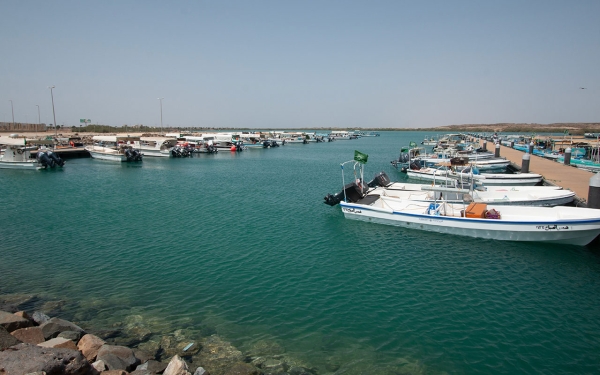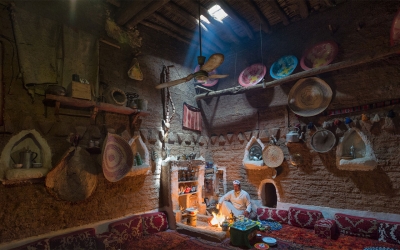

The Fishing Traditions in the Kingdom of Saudi Arabia are a set of traditions representing a cultural part of the heritage of the coastal regions in the Kingdom. On the coasts of the Arabian Gulf and the Red Sea, authentic customs and traditions related to fishing at sea have been rooted. They are associated with fishing by ships and include the mechanism of shipbuilding, the use of nets, pearl fishing, and customs of the departure of fishing boats and fishermen's return.
Songs and chants on fishing trips
Fishing trips are often accompanied by numerous songs and chants specific to each region, which fishermen sing while they fish. Fishing also involves specialized tools, which have now become traditional tools. The shipbuilders, known as 'al-Gallaf', were responsible for constructing and engineering boats or ships. They also engaged in carpentry work and calculated the necessary dimensions for the vessels. The term 'al-Gallaf' originates from ancient Arabic and refers to the process of peeling and removing the bark from trees.
Ships used in the Kingdom for fishing trips
The types of ships commonly used for fishing trips in the Kingdom include:
- Joury: A single-deck ship divided into compartments for supplies, used for fishing at a distance from the coast.
- Hawri: Used for fishing close to the coast.
- Sailing ships: Characterized by their large size, composed of two decks, and used for travel. Jeddah City was renowned for its production of sailing ships equipped with both sails and oars.
- Sails of ships: The manufacturing of ship sails, locally known as 'Tefsal Shar'ah', specializes in tailoring and sewing traditional ship sails. Those who work in this industry are called 'Muffasel Shar'ah' and are renowned for their skill and precision. This craft demands accurate calculation of sail proportions in accordance with recognized industry standards.
Fishing Methods
The methods of fishing in the Eastern Province varied in the past. Before the emergence of modern industries, fishermen continued to develop means to aid them in their livelihood. They established numerous fisheries of various sizes to fulfill their requirements.
The fishermen of the Eastern Province along the coast of the Arabian Gulf utilized the 'Hadra fishery' technique in shallow waters to catch various types of fish. This method involved deploying nets from top to bottom along the coast, taking into account the direction and flow of the water during tidal changes, particularly as it turned to low tide. This trapped the fish inside the nets. Subsequently, the catch was gathered using a device known as al-Maslat. This entire process was conducted by professionals with expertise in the profession and knowledge of sea conditions, often distinguished by the title of 'professors'. As common among sailors, the name 'Hadra' is derived from the practice of preventing fish from escaping the trap. The trap itself consists of several components including 'al-Sirr', 'al-Yad', 'al-Makhba', and 'Fana al-Hadra', all crafted traditionally decades ago using materials such as leaves, fibers, fronds, and palm stems. Over time, iron nets or 'al-Saym', nylon threads, and bamboo sticks were incorporated into the construction of the traps.
Maritime tunes in fishing traditions
Among the fishing traditions are the maritime tunes and melodies that 'al-Nahham' used to sing from the deck of the ship under the shade of the sails. The people in the Gulf region were able to express themselves and their concerns through various popular maritime arts, benefiting from their marine surroundings and incorporating everything they encountered into their musical expressions.
Types of maritime folk singing
'Al-Nahma' songs are a type of maritime folk singing known in the Arabian Gulf region, maintaining a distinctive presence in the list of popular arts. The inhabitants of the northwestern coast of the Kingdom engaged in maritime professions dictated by their surrounding environment, owing to the geographical location, economic circumstances, marine setting, and the passage of diverse cultures through the region, including maritime transport trade like shells and pearls, al-Yusr collection, coral stone collection, gathering of building stone, fishing, and boat and ship manufacturing. These professions were intertwined with stories, chants, customs, and traditions forming a maritime system where workers yielded to its demands, seeking sustenance.
There are also fishing activities for parrotfish in the Farasan Islands, which constitute a cultural heritage with roots dating back hundreds of years for the people of Farasan Island. The historian 'Ibn Mujawir' mentioned in his book about Farasan Island that this tradition has been associated with the people of Farasan since 1223, indicating that it is not a recent tradition but one that is much older.
Related quizzes
Related articles

